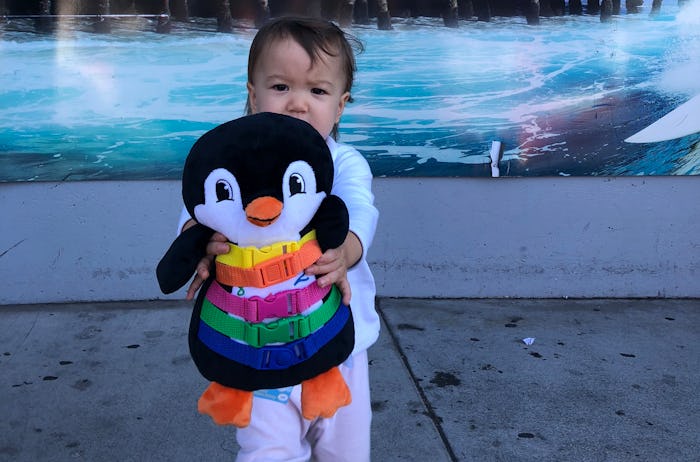Life

Turns Out Your Toddler Is Obsessed With Buckles For A Pretty Good Reason
You can buy a bunch of expensive, fancy toys for your toddlers, only to have them spend all their time fiddling with the buckles on their jackets or backpacks. So why do toddlers love buckles so much?
The phenomenon of toddlers loving buckles is so widespread that there’s a whole line of toddler buckle toys based on this fascination. As explained on the Buckle Toy website, the creators were inspired to develop the playthings after noticing their own toddlers obsessing over buckles. But why? I spoke to Dr. Robyn Koslowitz, the educational director of the Targeted Parenting Institute, who explains that this odd phase is a normal part of child development. “The toddler years are all about mastery and cause and effect learning. Toddlers are little scientists, always looking for the next experiment,” says Dr. Koslowitz, “Buckles, buttons and snaps are amazing examples of cause and effect. If I push THIS into THAT, I wonder what will happen? Oh wow! They are now connected! Can I connect something else? And how can I take them apart?!”
It's all part of the path toddlers take towards understanding cause and effect at around 8 months, according to the California Department of Education. That's when they start to do simple actions, and begin to take notice of what that action causes. At 18 months, children start to experiment with actions in order to create a desired outcome, like winding the handle of a jack-in-the-box. And at 36 months, children start to make predictions about what might happen if they try a certain action. This developmental pathway may be part of the reason buckles are so interesting: they’re a simple mechanical device that clearly demonstrates cause-and-effect. Keep in mind, too, that buckles are kind of a big part of your toddler's life. (How many times has your tot been buckled in and out of their car seat by now? Feels like thousands, probably.)
Dr. Koslowitz tells me the appeal of buckles doesn’t end here: “Another enjoyable aspect of buckling or snapping is the satisfying ‘click’ sound you get as you keep doing it,” she explains. Once your budding researcher learns they can cause the noise, they want to keep doing it over and over. Dr. Koslowitz says, “That ‘click’ is rewarding, and the little scientist wants to hear it again and again! Mom, maybe not so much, but we make sacrifices for our little Einsteins!”
Making noise certainly appeals to toddlers: As Professor David Elkind wrote for the More website, “Young children’s sensory systems are quite new and in the process of development. Perhaps they need noise, in part at least, to stimulate and nourish the auditory centers of the brain.” The combination of learning cause-and-effect, with satisfying tactile and auditory feedback, as well as the opportunity to practice new and developing motor skills, make buckles a satisfying and fulfilling little device for your toddler. And while the incessant clicking may start to wear on your ears, at least you know your toddler will be well prepared once they reach school-age for all those backpacks and seatbelts.
This article was originally published on